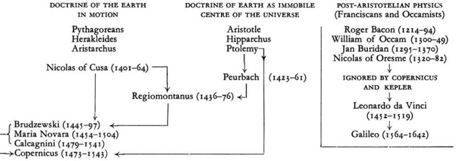The Sleepwalkers (103 page)
Authors: Arthur Koestler

None
of
these
questions
is
posed
in
the
Book
of
Revolutions
.
All
of
them
are
implicit
in
it.
All
of
them,
inescapably,
were
asked
sooner
or
later
by
the
Copernicans.
From
all
pre-Copernican
diagrams
of
the
Universe
there
emerges,
with
minor
variations,
always
the
same
reassuring,
familiar
picture:
the
earth
at
the
centre,
surrounded
by
the
concentric
shells
of
the
hierarchy
of
spheres
in
space,
and
the
hierarchy
of
values
associated
with
it
on
the
great
Scale
of
Being.
Here
be
tygers
and
here
be
seraphim:
every
item
had
its
assigned
place
in
the
cosmic
inventory.
But
in
an
unbounded
universe
without
centre
or
circumference,
no
region
or
sphere
ranked
"higher"
or
"lower"
than
another,
either
in
space
or
on
the
scale
of
values.
That
scale
was
no
longer.
The
Golden
Chain
was
torn,
its
links
scattered
throughout
the
world;
homogenous
space
implied
a
cosmic
democracy.
The
notion
of
limitlessness
or
infinity,
which
the
Copernican
system
implied,
was
bound
to
devour
the
space
reserved
for
God
on
the
medieval
astronomer's
charts.
They
had
taken
it
for
granted
that
the
realms
of
astronomy
and
theology
were
contiguous,
separated
only
by
the
thickness
of
the
ninth
crystal
sphere.
Henceforth,
the
space-and-spirit
continuum
would
be
replaced
by
a
space-time
continuum.
This
meant,
among
other
things,
the
end
of
intimacy
between
man
and
God.
Homo
sapiens
had
dwelt
in
a
universe
enveloped
by
divinity
as
by
a
womb;
now
he
was
being
expelled
from
the
womb.
Hence
Pascal's
cry
of
horror.
But
that
cry
was
uttered
a
hundred
years
later.
Canon
Koppernigk
in
his
tower
in
Frauenburg
would
never
have
understood
why
the
Reverend
John
Donne
made
him
a
pretender
to
the
seat
next
to
Lucifer's
throne.
With
his
blessed
lack
of
humour
he
foresaw
none
of
these
consequences
when
he
published
his
book
with
the
motto:
"For
Mathematicians
Only".
Nor
did
his
contemporaries.
During
the
remainder
of
the
sixteenth
century,
the
new
system
of
the
universe
went,
like
an
infectious
disease,
through
a
period
of
incubation.
Only
at
the
beginning
of
the
seventeenth
did
it
burst
into
the
open
and
cause
the
greatest
revolution
in
human
thought
since
the
heroic
age
of
Greece.
A.D.
1600
is
probably
the
most
important
turning
point
in
human
destiny
after
600
B.C.
Astride
that
milestone,
born
almost
exactly
a
hundred
years
after
Copernicus,
with
one
foot
in
the
sixteenth,
the
other
in
the
seventeenth
century,
stands
the
founder
of
modern
astronomy,
a
tortured
genius
in
whom
all
the
contradictions
of
his
age
seem
to
have
become
incarnate:
Johannes
Kepler.
CHRONOLOGICAL
TABLE
TO
PART
THREE

A.D. 1473 | 19 |
1483 | Death of |
1491-94 | Studies |
1496 | Made a |
c | Studies |
1503 | Promoted |
1506-12 | Secretary |
1509 | Publishes |
c | (1514 |
1512 | Joins |
1517 | Beginning |
1522 | Letter |
1533 | Widmanstad's |
1536 | Letter |
1537 | Dantiscus |
1539 | Summer. September. |
1540 | February. 1 July. |
1541 | 20 April. |
1540-41 | Summer |
1542 | May. June. June. November. |
1543 | 24 |
1576 | Death of |